The Moon has fascinated us for centuries, from its glowing beauty in the night sky to its role in astrology, folklore, and science. It’s an object of mystery and wonder, but there’s more to it than meets the eye. Here are 5 amazing facts about the Moon that you may not know.
The Moon began with an explosive collision
“The prevailing idea is that the Moon was formed in a violent event between the
proto-Earth – an early-stage Earth that was much bigger than it is today – and an object about the size of Mars, Modern research seems to confirm the Moon is made of material from the early Earth’s crust. Dubbed the ‘Giant Impact Hypothesis,’ this collision is believed to have happened 4.5 billion years ago and would have been 100 million times larger than the event which wiped out the dinosaurs.
It used to look much bigger
“The Moon started out around ten times closer to the Earth than it isnow, Computer simulations suggest the Moon could even have been 12-19 times closer, at a distance of just 20,000-30,000km, compared to 384,000km today. And it is still spinning away. “Because of a transfer of energy from the rotation and tidal bulges of the Earth, the Moon gets 3.78cm further away each year.” That’s roughly the same rate at which your fingernails grow.
Moon dust smells like gunpowder
“There is a lot dust on the surface of the Moon and the Apollo astronauts found
their suits covered in it when they climbed into their lunar modules, “One astronaut on the Apollo 17 mission likened its smell to that of gunpowder. The dust caused some astronauts a kind of ‘lunar hay fever.’” The sneezing and congestion took days to disappear. The good thing is there is no wind to blow it about.”
Surface temperatures reach boiling point
“Because the Moon has no protective atmosphere, the surface experiences
extreme temperatures, from incredibly cold on the far ‘night’ side and above boiling on the ‘sunny’ near side. According to NASA, the Moon’s temperature can span from 123 degrees Celsius to -233 degrees Celsius. Its mean surface temperature is 107 degrees Celsius in the day and -153 degrees Celsius at night.
The Moon causes tidal bulges
“Put simply, tides on Earth are the result of bulges in the water caused by the gravitational forces of the Moon, “Essentially the Moon pulls up water on one side of the Earth, but on the other side, where its gravitational forces are weaker, the water bulges in the opposite direction.” Those bulges move around the oceans as the Earth rotates, causing high and low tides around the globe. “Because tides are also influenced by gravity from the sun, without the moon we would still have tides but they would be smaller.”












